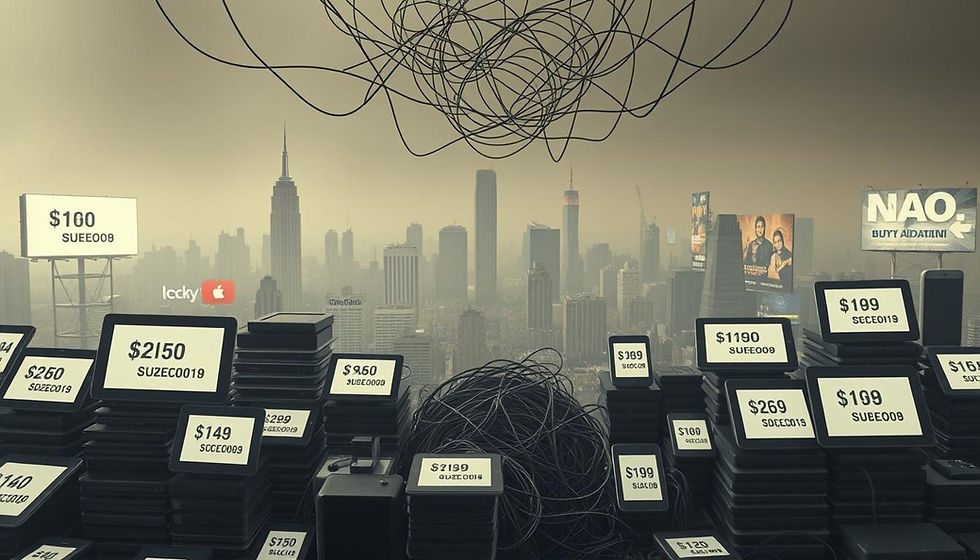From Free to Fee: The Silent Paywalling of the Internet
- Jomi Fashina

- Aug 18
- 5 min read
The internet has changed a lot over the years. It used to offer lots of free content. Now, you often need to pay to get information. This change, brought about by paywalls, is both quiet and significant.

Exploring the digital world shows us that digital publishing is now a complex field. The use of paywalling shows how content creators are making money. This change affects everyone, from publishers to users, and how we access the internet.
Key Takeaways
The internet is transitioning from free to fee-based content models.
Paywalls are increasingly used by digital publishers.
This shift impacts content accessibility and creator monetisation.
Consumers are adapting to new fee-based models.
The change reflects a broader evolution in digital publishing.
The Internet's Shifting Landscape
The web's early promise of open access has slowly faded. Now, paywalls and subscription models rule the online world.
The Original Promise of Free Information
In the beginning, the internet was seen as a game-changer. It was meant to make information free for everyone. Early Internet Idealism believed that knowledge should be shared without cost.
Early Internet Idealism and Open Access
The early internet was all about sharing and working together. People shared information without looking for anything in return.
The "Information Wants to Be Free" Era
This idea, from the 1980s, summed up a community that loved free information sharing.
The Gradual Transition to Paid Models
As the internet grew, so did the way it made money. The move from ads to subscriptions has been key.
From Advertising to Subscription Economics
With ad money going down, many sites now ask for subscriptions to keep going.
The British Experience: From BBC iPlayer to Premium Services
The BBC iPlayer, once free, now offers premium content. This change shows a wider shift in British online media.
Service | Original Model | Current Model |
BBC iPlayer | Free | Premium Content |
Streaming Services | Advertising-based | Subscription-based |
The Rise of the Paywall: Why Content is No Longer Free
Paywalls are becoming a major way for content monetisation in digital media. As money gets tighter, digital publishers are using paywalls to keep going.
Economic Pressures on Digital Publishers
The move to digital has put many publishers in a tough spot financially. The fall of print media and the fight to keep quality journalism are big reasons.
The Decline of Print Media in the UK
The UK's print media has seen a big drop in recent years. This has cut down the money publishers used to make from print sales and ads.
Quality Journalism's Fight for Survival
Quality journalism needs a lot of money, but with less money coming in, it's hard to keep up standards. Paywalls could help by giving a direct way to make money.

The Collapse of Ad-Based Revenue Models
The old way of making money from ads is failing. This is because of ad-blockers and the big role of Google and Facebook.
Ad-Blockers and Their Impact
More people are using ad-blockers, which hurts the old ad-based way of making money. This has pushed publishers to look for new ways to earn.
The Google-Facebook Duopoly
Google and Facebook are taking most of the digital ad money. This leaves publishers with less, making them look for new ways like paywalls.
The Hidden Costs of Digital Consumption
The internet is changing fast, and so are the costs of using it. More and more services need subscriptions, making things pricey and hard to get to for everyone.
Subscription Fatigue: How Many Services Can We Afford?
British homes are finding it tough to manage all the subscription services. There's so much to choose from, like streaming and news, and it's getting expensive.
The British Household's Digital Budget
Studies show that families spend about £50 a month on digital subscriptions. This is making it hard for many to keep up with their bills.
When Everything Requires a Subscription
More and more things are becoming subscription-only. This means people keep paying month after month, even if they're not getting much for their money.

The Digital Divide: Who Gets Left Behind?
The move to pay-for-access is widening the digital gap. Those with less money are finding it harder to keep up with the online world.
Access Inequality in Modern Britain
The digital gap isn't just about having a computer. It's also about being able to pay for what's online. This can limit learning and access to information.
The Social Cost of Information Barriers
As more sites charge for access, some people might miss out on important talks. This could harm our democracy and chances for economic growth.
Service Type | Average Monthly Cost | Percentage of Households Subscribing |
Streaming Services | £15 | 70% |
News Outlets | £10 | 40% |
Software and Tools | £20 | 30% |
Conclusion: Navigating the Fee-Based Future
The internet is changing fast, with more sites using paywalls and charging for access. This shift is making digital publishing rely more on subscriptions. It's changing how we get our online news and information.
I need to get used to the idea that good content might cost money. Knowing why digital publishers are turning to paywalls helps us understand this change. It's all about the money, as ad revenue isn't enough anymore.
It's important for us to know the true cost of using the internet. Issues like subscription fatigue and the digital divide are real. By choosing wisely what we pay for, we can keep the internet useful for everyone.
The future of online content will likely have both free and paid options. Paywalls will get smarter. As users, we must learn to find our way in this new world to get the information we need.
FAQ
What is paywalling, and how does it affect online content?
Paywalling means you need to pay to see some online content. It's becoming more common. This changes how we get our news and information.
Why are paywalls becoming more common on the internet?
Digital publishers face tough times. Print media is fading, and ads don't bring in enough money. So, they're starting to charge for content.
How has the British experience influenced the rise of paywalls?
Britain's move from free to paid services has set a trend. It shows the need for stable income from online content.
What is subscription fatigue, and how does it affect consumers?
Subscription fatigue is feeling overwhelmed by too many services. It makes people think they can't afford or keep up with them. This limits what they can see online.
How does paywalling contribute to the digital divide?
Paywalls make it hard for those who can't pay to access content. This creates a gap in information access. It's unfair and affects society.
Can ad-blockers affect the revenue models of online publishers?
Yes, ad-blockers hurt publishers' income by blocking ads. This has led some to start charging for content instead.
How has the Google-Facebook duopoly influenced the online advertising landscape?
Google and Facebook's big share of ads has cut into others' income. This push has made publishers look for new ways to make money, like paywalls.
What can consumers do to navigate the increasingly fee-based online landscape?
To deal with more online fees, pick your subscriptions wisely. Look for free or cheap options. And keep an eye on your spending online. Being smart about it can help you cope with paywalls.
%20-%20Used%20for%20Marketing%20Purposes%20.webp)





Comments